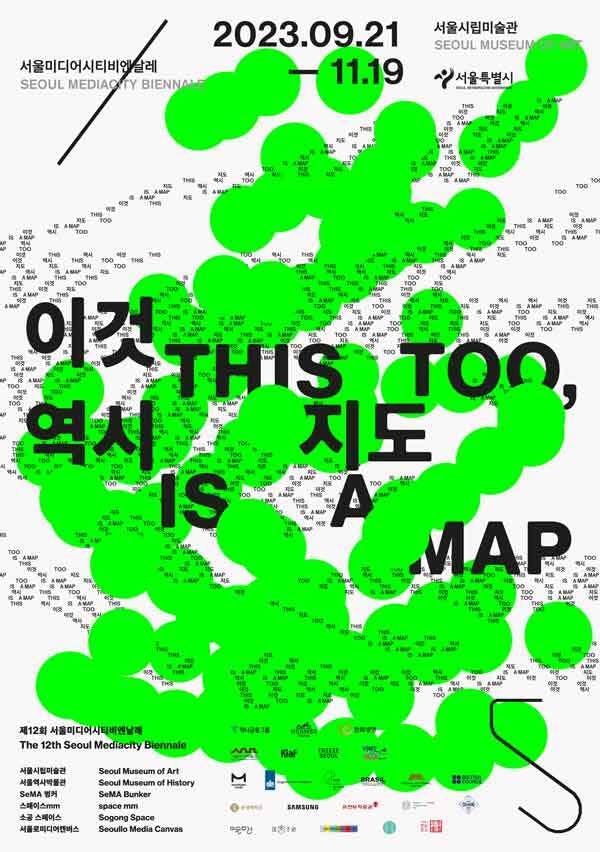
THE 12th SEOUL MEDIACITY BIENNALE <THIS TOO, IS A MAP>
Sep 21 - Nov 19, 2023
61, Deoksugung-gil, Jung-gu, Seoul, 04515, Rep. of KOREA
FREE
Weekdays (Tue–Fri) 10am - 8pm
Sat· Sun · Public Holidays
- Summer (Mar-Oct) 10am - 7pm
- Winter (Nov-Feb) 10am - 6pm
The last Wednesday of each month 10am - 10pm
Closed day 01.01
Entitled THIS TOO, IS A MAP, the 12th Seoul Mediacity Biennale (SMB12) will open to the public at Seoul Museum of Art and several other venues across the city of Seoul from 21 September to 19 November 2023. A press and professional preview day will take place on 20 September. Developed to imagine the global aesthetics of the non-territorial, the project focuses on alternative concepts of mediating and relating that live outside of borders and looks to the necessity of abstractions and hidden and deliberately obscured languages to communicate shared existence. The project refers to the global relations that take place within Seoul and its industrial surroundings, and the positions and references of those willingly and unwillingly displaced, often multiple times over, whether within or outside of the city and state. The Biennale looks at systems imposed or created outside of national borders, including transnational solidarities, “underground” commitments, the coded mapping of data and infrastructure, as well as those of artistic and political communication.
Honoring Seoul Mediacity Biennale’s tradition of creating new and alternative networks, THIS TOO, IS A MAP spreads across multiple venues throughout Seoul. Each distinct location embraces objects and concepts that respond to the Biennale and reflect unique local and spatial characteristics. These venues include SeMA Seosomun Main Branch, the neighboring Seoul Museum of History, the outdoor Seoullo Media Canvas, and several underground spaces dispersed around the city such as space mm and Sogong Space―located in an underground shopping center―and SeMA Bunker. Augmenting these venues are a series of collaborating spaces that share programs, postcards, guidebooks, newsletters, and maps to offer additional means of navigating the Biennale and the city.
The largest manifestation of SMB12’s exhibition and programs takes place at SeMA’s Seosomun Main Branch. Spanning installation, time-based media, painting, sculpture, drawing, textile, wallpaper, and sound, the exhibition explores the global aesthetics of the non-territorial from physical and cultural displacements and replacements, to “unseen” infrastructures and media, to multisituated alliances. Each gallery explores a different approach to non-territorial aesthetics, including artworks that make alternative maps, abstract history and identity, re-present displacement and migration paths, and communicate through cybernetic and indigenous positions. Along with the museum’s gallery spaces, its lobby, courtyard, hallways, rooftop, Project Gallery, and Crystal Gallery also present new and commissioned works as well as special events.
시, language for new moons presented at the Seoul Museum of History is a survey exhibition of Jesse Chun, whose immersive poetics in moving image, drawing, installation, and sculpture invoke delicate questions about language and power. Chun was born in Korea and subsequently lived in Korea, Hong Kong, Canada, and the United States, where she observed the marginalization of non-English languages, particularly non-Western narratives and histories. Drawing from sustained connections to her own matrilineal history, Korean folk literature, and the country of her birth, Chun uncovers the “other side” of language, mapping its various cosmologies. By deconstructing languages into fragments of phonemes, characters, images, and constellations, Chun embraces linguistic abstractions that fracture its social and semiotic structures. In presenting these works at Seoul Museum of History, she extends to visitors an inimitable opportunity to summon new languages, hybrid memories of culture, time, meaning and the experience of beginning anew―from her grandmother’s shamanic dance to the act of translating cross-territorial becomings. In the context of the museum, Chun’s works unfold new ways of seeing the histories and poetics that percolate through Seoul, arising from preservation, complexity, devotion, and reinvention.
Prior to opening to the public in 2017 as a satellite branch of SeMA, the underground gallery of SeMA Bunker is believed to have been built as a secret shelter during the military regime in the 1970s. Just as THIS TOO, IS A MAP engages with underground, historical, political, and cultural infrastructures of extraction and displacement, the works on view at SeMA Bunker investigate the links between human, technological, and mineral displacement. This presentation focuses on the mapping of physical underground ecologies through histories of extraction, pollution, and natural resources.
The underground passageways connecting the City Hall and Euljiro stations of the Seoul Metropolitan Subway, located between the Plaza Hotel and the Myeongdong Underground Shopping Center, are home to a sea of commercial spaces that sell souvenirs, street food, clothes, and K-pop merchandise. Among these vendors are space mm and Sogong Space, where SMB12 presents artworks by Hyunsun Jeon and Bo Wang, artists who engage with the politics and tensions that emerge from the blurred boundaries between public and private spaces, and between the virtual and real territories of everyday life.
Seoullo Media Canvas is a giant 29 by 7.7 meter media screen that is visible from Seoul’s elevated pedestrian walkway Seoullo 7017 and Malli-dong Square, destinations that attract individuals from surrounding residential communities into the city center. This venue frequently screens works by young and emerging artists on topics relevant to the future of the city. Every evening, SMB12 presents a brief hourly program of new and recent works by celebrated artists that connect with the themes of the Biennale.